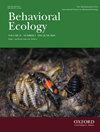感官陷阱能带来可靠的交流,而不会改变对模型线索的非性反应
IF 2.2
3区 环境科学与生态学
Q2 BEHAVIORAL SCIENCES
引用次数: 0
摘要
信号进化的感觉陷阱模型表明,雄性利用模仿非性环境中使用的线索的特征来操纵雌性交配。尽管感觉陷阱得到了很多经验支持,但人们对雌性如何进化以应对这些欺骗性信号却知之甚少。雌性海鳗(Petromyzon marinus)在进化过程中能够从其模仿的幼体气味中分辨出雄性性信息素,并在寻找配偶时只面向雄性。幼体和雄性都会释放引诱剂 3-keto petromyzonol sulfate(3kPZS),但产卵的雌性会使用信息素拮抗剂 petromyzonol sulfate(PZS)来避开幼体的气味。我们测试了一个假设,即洄游雌性在溯河洄游时也会区分幼虫气味和雄性信息素,并只对幼虫气味定向,此时它们会在开始寻找配偶之前利用幼虫气味在产卵溪流中导航。溪流中的行为试验表明,与产卵雌鱼不同,洄游雌鱼不会区分3kPZS和PZS的混合物,其比例是幼虫气味与雄性气味的典型比例。我们的研究结果表明,雌鱼在交配期间能区分3kPZS的有性来源和无性来源,但在交配之外却不能,这表明感官陷阱能导致可靠的性交流,而不会改变雌鱼在原始环境中的反应。本文章由计算机程序翻译,如有差异,请以英文原文为准。
Sensory trap leads to reliable communication without a shift in nonsexual responses to the model cue
The sensory trap model of signal evolution suggests that males manipulate females into mating using traits that mimic cues used in a nonsexual context. Despite much empirical support for sensory traps, little is known about how females evolve in response to these deceptive signals. Female sea lamprey (Petromyzon marinus) evolved to discriminate a male sex pheromone from the larval odor it mimics and orient only towards males during mate search. Larvae and males release the attractant 3-keto petromyzonol sulfate (3kPZS), but spawning females avoid larval odor using the pheromone antagonist, petromyzonol sulfate (PZS), which larvae but not males, release at higher rates than 3kPZS. We tested the hypothesis that migratory females also discriminate between larval odor and the male pheromone and orient only to larval odor during anadromous migration, when they navigate within spawning streams using larval odor before they begin mate search. In-stream behavioral assays revealed that, unlike spawning females, migratory females do not discriminate between mixtures of 3kPZS and PZS applied at ratios typical of larval versus male odorants. Our results indicate females discriminate between the sexual and nonsexual sources of 3kPZS during but not outside of mating and show sensory traps can lead to reliable sexual communication without females shifting their responses in the original context.
求助全文
通过发布文献求助,成功后即可免费获取论文全文。
去求助
来源期刊

Behavioral Ecology
环境科学-动物学
CiteScore
5.20
自引率
8.30%
发文量
93
审稿时长
3.0 months
期刊介绍:
Studies on the whole range of behaving organisms, including plants, invertebrates, vertebrates, and humans, are included.
Behavioral Ecology construes the field in its broadest sense to include 1) the use of ecological and evolutionary processes to explain the occurrence and adaptive significance of behavior patterns; 2) the use of behavioral processes to predict ecological patterns, and 3) empirical, comparative analyses relating behavior to the environment in which it occurs.
 求助内容:
求助内容: 应助结果提醒方式:
应助结果提醒方式:


